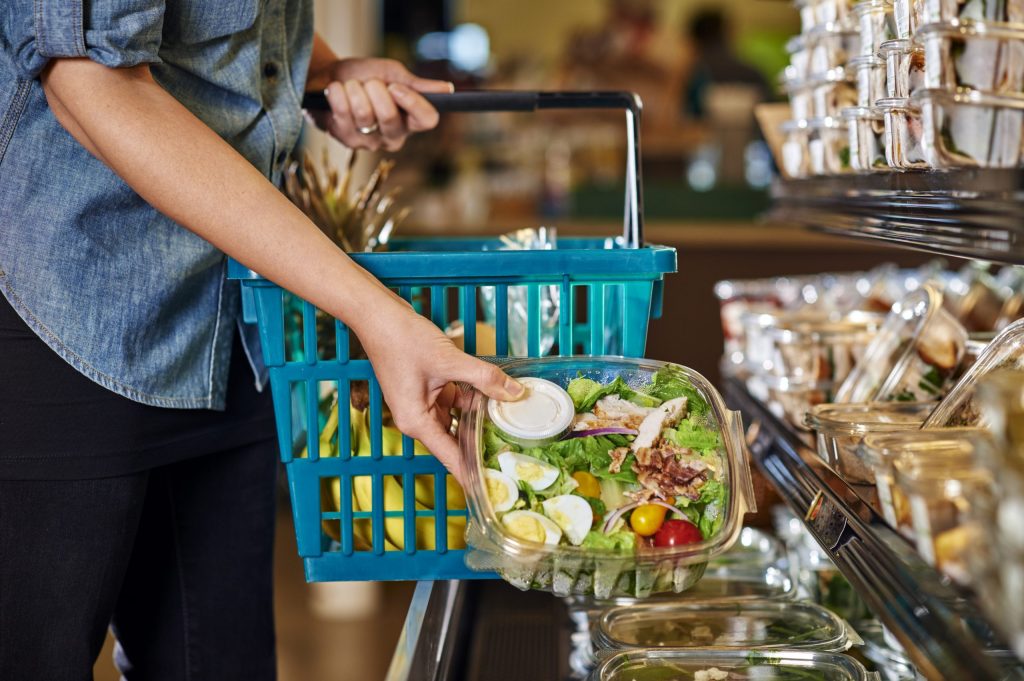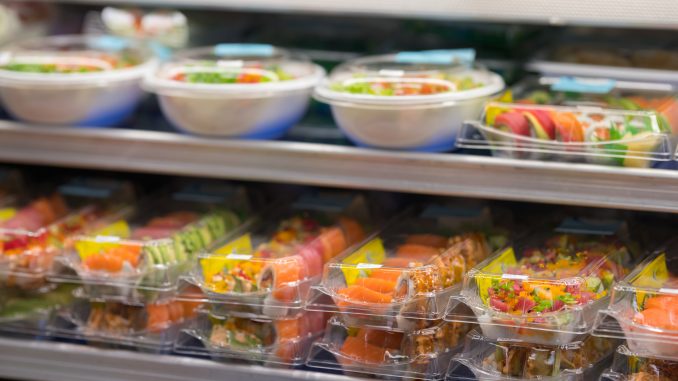Fresh and Fast
October 1, 2019 | 7 min to read
Today’s consumers demand quick, fresh food options that align with their busy lifestyles. An insightful survey by Culinary Visions revealed that while the definition of ‘fresh’ varies, most people appreciate the variety offered by delis and prepared food services. With 70% of respondents acknowledging that local delis provide ample convenient fresh food choices, it's clear that deli operators are successfully meeting consumer expectations for a balance between healthful and convenient options.

Today’s consumers’ lives are speeding up, and they expect their fuel to match their pace. But “fast” food isn’t limited to the quick-service and convenience channels anymore. Leaders in deli, prepared foods and retail foodservice are stepping up their offerings, as consumers search to strike a balance between fresh versus fast, healthful versus convenient and large versus local. Chicago-based Culinary Visions delved deep into consumers’ quest for fresh food they can take on the go in a survey of 1,500 consumers from across the nation.
While the word ‘fresh’ can be difficult to pin down, gaining access to the unique perspectives of a variety of demographics helped open up insights into what consumers expect from fresh food, how their perceptions of fresh food influence their purchasing decisions and which characteristics most define it.
Regardless of individual consumers’ responses regarding their fresh food preferences and spending habits, deli operators can feel confident that they are doing something right. Seventy percent of all consumers surveyed said their local deli has plenty of convenient fresh food options.

Fast and Youth-Driven
The study found that younger consumers ages 18-34 are the most interested in grab-and-go foods, consistently expressing the most interest in concepts they can quickly purchase and take away to eat later at their convenience across the deli, prepared foods and foodservice markets.
Food from the supermarket deli received high marks from all demographics, with 77 percent of all consumers surveyed responding that they are likely to purchase freshly-prepared food from a deli. But when broken down, the most enthusiasm still came from younger consumers. Eighty-two percent of those ages 18-34 said they were likely to purchase freshly prepared food from the deli, compared to 76 percent of those ages 35-54 and 73 percent of those ages 55 and older.
Fifty-five percent of all consumers surveyed said they were likely to purchase a grab-and-go sandwich from the deli. While this slight majority may not seem astoundingly impressive, much greater interest emerged when age demographics were isolated. Sixty-eight percent of consumers ages 18-34 said that they would be likely to purchase grab-and-go sandwiches from a deli, compared to 57 percent of consumers ages 35-54 and 44 percent of those ages 55 and older.
And when it comes to grabbing a quick bite from a convenience store, the division between age groups grew even wider. Fifty-two percent of consumers ages 18-34 said they enjoy eating food from convenience stores, compared to 40 percent of those ages 35-54 and 20 percent of those ages 55 and older.
Only 38 percent of consumers surveyed agreed with the statement that convenience store retail items are just as fresh as prepared items from the deli. The perceived edge that delis have may in fact be due to the easy access they have to building their sandwiches from freshly-baked bread. Seventy-seven percent of consumers said that in-store bakeries offer a good variety of fresh food options, and 79 percent of all consumers said that bakery items are fresher when baked on-site.
Another appealing factor that attracts younger consumers to grab-and-go may be that the deli doesn’t make them feel like they have to make a trade-off between great taste and convenience. Seventy percent of consumers ages 18 to 34 said that prepared items from the deli are just as fresh as items made to order, compared to 60 percent of consumers ages 35-54 and 53 percent of consumers ages 55 and older. In the deli, younger consumers find that they can achieve harmony with delicious options that are both fresh and fast. Clear plastic packaging communicates a key role in evaluating deli food’s freshness. But it turns out that the healthfulness of the ingredients consumers see might not matter as much to them as the fact that the food inside that packaging is fresh.
While an overwhelming 85 percent of all consumers surveyed reported that transparent packaging is important when it comes to defining fresh food, consumers were still split when it came to choosing between healthfulness and indulgence. Forty-eight percent of consumers responded that they don’t care about healthfulness when it comes to snacking on the go. When fast is the priority, consumers are more willing to bend restrictions, inviting deli operators to present a wider and more unique range of offerings for consumers’ consideration.
Evolving understandings of what constitutes healthy also have an impact on consumers’ decision-making for grab-and go-purchases. Consumers used to fear certain ingredients like fats and carbohydrates. Now, “good” unsaturated fats are in vogue, as many consumers pay extra to add avocado to their sandwiches and find themselves ditching the idea of diets.
Eighty-five percent of consumers said they think people get too caught up in food fads, and 81 percent of consumers said that they shouldn’t have to try too hard to eat healthy. Furthermore, 70 percent of consumers agreed that when it comes to eating healthy, people tend to overthink it.
Freshness may be important, but the study reveals that as the definition of healthy continues to expand to encompass multiple aspects of wellness, consumers do not necessarily view fresh and healthful as one and the same.
Fast but Not Delivered
Food delivery services have exploded in popularity with such intensity over the last few years that the names of all of the numerous apps have become difficult to distinguish, let alone to squeeze into your smartphone’s storage capacity.
For tech-savvy consumers, they make ordering food directly to your door—or wherever you are, for that matter—as effortless as lifting a finger.
That’s why it’s surprising that younger consumers were the demographic least likely to say that they find delivery to be fresh. According to the study, 58 percent of consumers between the ages of 18 and 34 agreed that delivered food is rarely fresh, compared to 52 percent of consumers between the ages of 35 and 54. Baby Boomers were the demographic most likely to spring to delivery’s defense, with only 37 percent of those ages 55 and older agreeing with the statement that delivery food is rarely fresh.
Stacked up to prepared foods, delivery was outdone. Sixty-four percent of those ages 18-34 said that refrigerated prepared foods taste fresh.
As for older consumers, that number held steady with 65 percent of those ages 35-54 and 65 percent of those ages 55 and older agreeing that refrigerated prepared foods taste fresh.
What accounts for this perceived discrepancy? Not a technological aspect, certainly. It’s not just a stereotype that younger shoppers tend to gravitate toward digital interfaces to mediate their purchases; 43 percent of those ages 18-34 said they prefer to use a kiosk or touch screen for ordering their meals, compared to only 28 percent of those ages 35-54 and a mere 9 percent of those ages 55 and older.
And the reason doesn’t seem to be because their food isn’t arriving fast enough either, with 48 percent of those ages 18-34 responding that they use a kiosk or touch screen to order their meals more quickly.
Rather, it seems that younger consumers connect freshness with food they can easily trace to its source. Sixty-eight percent of consumers ages 18-34 said they like to purchase items that tell them where the ingredients have come from.
While ordering delivery often involves layers of multiple middle-men, refrigerated prepared foods benefit from their trustworthy locations in supermarkets and the deli. When it comes to freshness, handy grab-and-go items like grilled chicken hummus wraps and quinoa salads often beat delivery.

Fast and Ethical
The word “ethical” is joining fresh, healthful and flavorful on consumers’ list of demands. Today’s conscious consumers don’t want their dining decisions to have any unintended negative consequences on the world, and they’re trying to limit that impact by examining the way their choices influence the environment, labor practices and their communities.
One form through which this trend has manifested is through farm-to-table restaurants, restaurants that tout their direct lines to farms, fishermen and other producers. Seventy-nine percent of consumers surveyed said they love farm-to-table restaurants, and 77 percent of consumers say that they believe farm-to-table food tastes better. Sixty-two percent of consumers said that they actively seek out restaurants that menu responsibly produced foods.
Ethical isn’t limited to in-restaurant dining experiences. In fact, this growing trend has begun reaching its way into the world of quick fuel, too. Fifty-seven percent of consumers said that there aren’t enough ethically-produced snacks available to them, and 55 percent said that they would be willing to pay more for food they grab on the go if they knew it was ethically produced.
So what are consumers looking for when they say they are seeking out food that is fast and ethical? The results demonstrated that the word is a sweeping term that can cover a range of considerations, from the material resources that go into the production and preparation of food, to the people providing the manpower for the operation. Sixty-six percent of consumers said that they care about ordering protein that is sustainably raised or caught, and 87 percent of consumers said that they like to patronize businesses known for treating their employees well.
And while using transparent, plastic packaging is an effective merchandising strategy in allowing consumers to see for themselves if food is fresh, the bulk of the packaging can carry other implications, as well. Sixty-five percent of consumers said that the environmental impact of takeout containers and to go boxes concerns them, and 83 percent said they wished operations would use more environmentally-friendly business practices. Fast options that take the steps to alleviate consumers’ hesitations, whether through grab-and-go packaging that denotes it’s recyclable or a label that boasts fair trade certification, will make consumers feel good about where they put their money. DB
Sharon Olson is Executive Director of Culinary Visions®, a division of Olson Communications based in Chicago. Culinary Visions is a food-focused insight and trend-forecasting firm that provides original consumer and culinary professional research for companies in the food industry.
2 of 9 article in DeliBusiness Oct/Nov 2019

